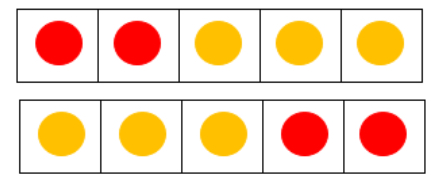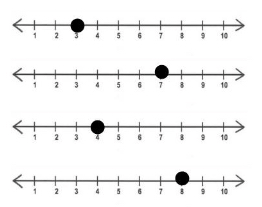General Information
Benchmark Instructional Guide
Connecting Benchmarks/Horizontal Alignment
Terms from the K-12 Glossary
- Commutative property of addition
- Equation
- Expression
- Number Line
Vertical Alignment
Previous Benchmarks
Next Benchmarks
Purpose and Instructional Strategies
The purpose of this benchmark is to explore addition and lay a foundation for fluency in later grades. This benchmark provides the foundation for the strategy of making a 10 that can be used as the scale of addition increases in later grades (MTR.5.1).- Instruction allows students to flexibly discover addends that make 10 using strategies and manipulatives. Strategies and manipulatives include addition and subtraction facts, counting with fingers, ten frames, number lines, models and drawings (MTR.2.1).
- Instruction includes the use of the commutative property (not by name) as a strategy for adding.
- For example, allow students to discover that 7 + 3 = 10 and 3 + 7 = 10 to build their understanding and extending it to find new sums. If a student knows 4 + 6 they now also know 6 + 4 (MTR.5.1).
- Instruction allows for students to develop verbal explanations as they learn to justify and explain their thinking (MTR.4.1).
- Instruction includes making a connection to related subtraction facts.
- For example, saying that the number you add to 3 to find 10 is 7 is the same as 10 − 3 = 7.
- Though there is no expectation that students name the commutative property, they should begin to discover the connections and patterns and recognize that if a + b = 10, then b + a = 10.
Common Misconceptions or Errors
- Students may not connect pairs of addends through the commutative property.
Strategies to Support Tiered Instruction
- Instruction includes opportunities to build sets of ten using snap cubes to represent the commutative property.
- For example, students build 8 + 2 and 2 + 8, 7 + 3 and 3 + 7, and 4 + 6 and 6 + 4. Students should write an expression to represent the snap cubes. Teacher asks: How is the set of 8 + 2 and 2 + 8 the same? How are they different? Does it matter which addend comes first? Do you get the same sum if you add them in a different order?

- Instruction includes opportunities to use five frames and two-color counters to represent addition fact families that represent the commutative property.
- For example, students use five frames to represent the expressions 3 + 2 and 2 + 3. Teacher should guide the students to solve the expressions and notice their sum in relation to the order of the addends.

Instructional Tasks
Instructional Task 1
Provide students with ten two-sided counters, a cup and a ten frame. Students will dump the counters out (some will be one color face up, some will be the other color face up) and organize them onto the ten frame. With provided space students will record an addition equation that represents their counters; such as 3 + 7 = 10. Repeat the task allowing students to discover the various addends that give the sum of 10. Give students time to record their discoveries and discuss strategies and addend pairs with peers and teachers.Enrichment Task 1
Patty has 3 pennies. How many more pennies will Patty need to have the same amount of money as one dime?Enrichment Task 2
Mark has a dime and wants to buy a piece of candy from the school store that is worth 6 pennies. How many pennies will he receive in change?
Instructional Items
Instructional Item 1
Omar knows that 3 + 7 = 10, so he believes that 7 + 3 must also equal 10. Is Omar correct?
How can we use that relationship to write a new equation if we know that 6 + 4 = 10?
Instructional Item 2
Use the number lines to determine how close each number is to 10.
*The strategies, tasks and items included in the B1G-M are examples and should not be considered comprehensive.
